
Publisher:
Bonnie King
CONTACT:
Newsroom@Salem-news.com
Advertising:
Adsales@Salem-news.com

~Truth~
~Justice~
~Peace~
TJP
Jun-03-2023 14:57


 TweetFollow @OregonNews
TweetFollow @OregonNews
Thacker Pass, An Archaeological Perspective
Robert Lundahl special to Salem-News.comWe want to do better, but we’re doing the worst possible thing. And sometimes we confuse the two.
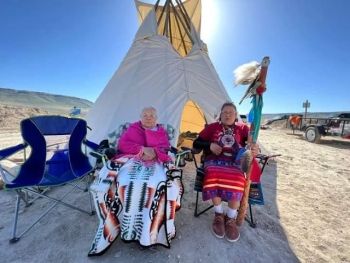 Elder Josephine Dick and her niece, Dorece Sam, Fort McDermitt Pai-Sho Tribe |
(LOS ANGELES, Calif.) - There are laws, and then there are the interpretation of laws and the execution of justice.
Imagine that the laws protect the most beautiful land, that is your home and home to living communities of animals, plants and other people who have been there forever, and someone wants all that to be graded down to dust, why?
- Because... it's in the way of the wealthy, the greedy, and the well–intentioned.
And you hear, "I'm sorry, there is no time, let's move this along."
You may be number 3, or maybe you're number 10.
It doesn't matter.
It's go, go. go. We're moving.
–Bill Powers P.E., Who Are My People? Film, Robert Lundahl, 2015/2023
Austin Ringelstein joined the U.S. Navy before 911. After, he wound up on the bomb squad, defusing munitions in Iraq. Coming home, he applied his discipline and fortitude in the field of archaeology.
Now he's on a "bomb squad" of a different kind. He's helping to defuse the "bombs" of failure to consult and its resulting disharmony.
In this interview and podcast, Austin addresses the "abysmal" attempts to come together in better understanding at Thacker Pass, and explains how a more harmonious balance with each other, and with the Earth, is possible.
EXCLUSIVE INTERVIEW with Austin Ringelstein:
 Austin Ringelstein |
I ended up, the last three years, becoming the park archaeologist at the Santa Monica Mountains National Recreation Area, so I've sort of been thrown into what's called Section 106 of the National Historic Preservation Act, which is the main federal policy that guides archaeology and archaeological compliance, when it comes to federal undertakings.
A Reasonable and Good Faith Effort
Basically, whenever you have a federal undertaking, which could be any action that could result in impacts to archaeological resources or cultural resources, or any undertaking that is funded by the US government, you have to do an archaeological assessment to consider the impacts that the undertaking might have on cultural resources.The key word there is that these agencies have to consider the impacts, which unfortunately doesn't give a lot of teeth to the law.
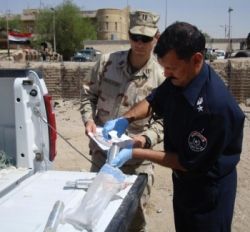 Austin Ringelstein assists an Iraqi police |
But it does at least mandate that an archaeological assessment is done.
It really has to be a good faith effort to survey an entire area, which is known as an area of potential effect, where the project might impact resources.
That reasonable and good faith effort is really all dependent on who's doing it, but luckily the consultation process allows for checks and balances to make sure that a good job is done.
That checks and balances process means that archaeologists are constantly working with the stakeholders, which in most cases are tribes, as well as the State Historic Preservation Offices.
So really, any time there's a federal undertaking you're going to do a pedestrian intensive survey of the area potential effect, and then produce a report of your findings.
The last step is consulting with the stakeholders, as well as the State Historic Preservation Office to determine what the potential impacts of the undertaking might be.
Robert Lundahl:
Well, those are all processes that I'm a little familiar with and would expect, and as you say, the idea of a good faith effort, I guess, applies to what level of diligence, but also how much time they have, and how much pressure they're under.
As we were discussing, I was surprised by Thacker Pass, the quick permitting under the Mining Act, the fast tracking... Can you talk about that a little bit?
Fast-tracked
Austin Ringelstein:I, of course, have worked in the Santa Monica Mountains National Recreation Area, but just having examined the EIS from Thacker Pass and reading some of the materials that have come out about Thacker Pass, there seems to be a consensus that the project was fast-tracked.
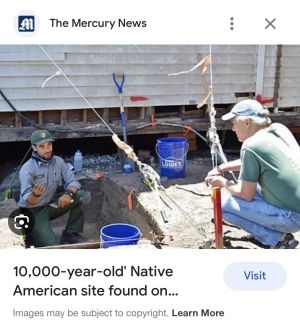
From an archaeological perspective, you have to wonder- can you actually do a reasonable good faith effort when you have a condensed timeline? And when it comes especially to consultation, that's antithetical to that process.
The Department of the Interior has put out directives and policy regarding consultation, which say that you need to do consultation early. And often– it's more of an indigenous perspective than an existing capitalist perspective that we need to take time to build relationships and also to make sure that people can reach a consensus.
When you fast track a project, you don't allow that space for proper communication, for archaeological sites to be interpreted, for tribes to actually gather themselves and be able to speak about the value and significance of their resources, and to even to know what they're working with.
Really, the larger the scope of a project the greater amount of time should be allotted to that process. So there's no doubt that fast-tracking a project because of a so-called deadline creates disharmony and is actually antithetical to the spirit of Section 106 and the cultural resources laws that we’re guided by under federal law.
Robert Lundahl:
We're in the middle of this enormous push and pressure in industry and government for Green Energy Solutions and one of those is lithium for EV batteries for electric cars, the electrification of the transport system globally in response to climate change.
Then all that pressure is brought down. It seems like 18,000 acres is a lot but really you know when you're looking at a situation where we might say the whole world is watching, that 18,000 acres becomes extremely important, and the pressure gets extremely high.
An Abysmal Attempt
What do you think happened at Thacker Pass that was creating disharmony? And, why is there a gap between the statements from Dorece Sam and others that you saw in the video and the process that they described?For example, Dean Barlese says no one talked to us, no one came and talked to us.
And Dorece says it was a massacre site- so we know that they got surprised ...and all their living utensils and tools and hunting gear is out there, not to mention the bones that sink into the earth over time, not having been buried, nothing having been buried in two massacres.
I mean, it seems like an extreme situation.
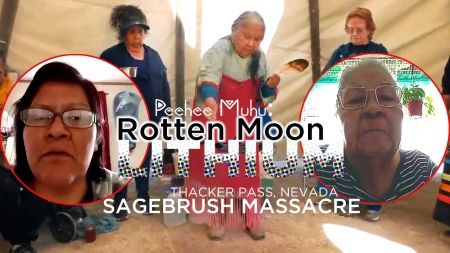 Read the article in Salem-News here. Watch the video on YouTube here. |
Austin Ringelstein:
Well, in my opinion it does, and I would agree with that. Again, the larger the scope of a federal undertaking the greater the amount of consultation and due diligence to meet with the stakeholders and to come to some kind of consensus.
When you have 18,000 acres and over a thousand recorded archaeological sites this is a massive undertaking. So, the fact that three letters were sent to three tribal groups and there doesn't seem to be much evidence of follow-up to actually reach those folks, is in my opinion an abysmal attempt at consultation.
And really, the buzzwords here are meaningful consultation. Of course that can be defined differently by different people but there has been policy and guidance put out that when you can, you want to meet with tribal members face to face.
You want to have really good listening sessions in terms of hearing the tribes, to be able to understand what their perspective is and understand what values they assign to different resources.
So saying that we sent letters out and didn't hear back during the pandemic and during a fast-track timeline is certainly not a good faith effort to have meaningful consultation.
I don't know the nuances or details of that process, but there hasn't been evidence to the contrary that there was meaningful consultation ever done.
The very fact that numerous tribal members, especially elders, have issues with this project in terms of their sacred sites and their archeology, and the fact that they have assigned values to Thacker Pass that are incredibly culturally significant, means that there is a conflict that hasn't had any kind of resolution.
When I look at it from an objective Section 106 standpoint, you have over 50 National Register eligible significant archaeological sites within the direct impact area, and then an additional 30 plus sites in the indirect impact area that are National Register eligible.
Right there is evidence of an incredible amount of impact, adverse effect, that's going to happen to this place, and the bottom–line is that it was very minimally addressed in the EIS.
There hasn't been any viable pathway for mitigation spelled out in the EIS.
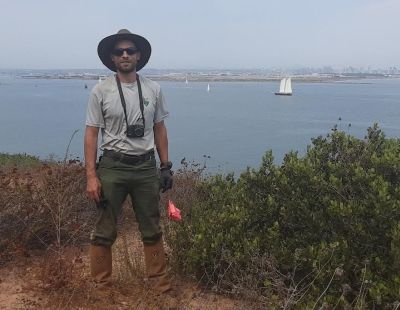 Austin Ringelstein in the field. |
Appropriate to Scale
Robert Lundahl:Well I think a lot of people in the public are unaware of all of this and when you look at it from their point of view, it's not unlike my point of view when I started the film "Who Are My People?", and I realized that no consultation had taken place.
That was difficult for me to understand, and it seemed wrong, unfair.
Austin Ringelstein:
In terms of your earlier question about these sites, in terms of fast-tracking the project and consultation and how that all played out in such a condensed timeline...
You know, one thing that I made note of was that while they may have potentially met some of the minimum standards for Section 106, they certainly failed to do meaningful consultation to assess the value of cultural resources to existing indigenous people, and the guidance by The Advisory Council for Historic Preservation, who should have an opportunity to comment about this project.
That consultation should be carried out in a manner appropriate to the scale of the undertaking and the scope of the federal involvement, so when you have a project this large, the consultation process should be done in a really thorough and thoughtful manner.
I mean, I've looked at projects that I've done with the National Park Service and our level of consultation was greater than this project for a small site and a very small undertaking, so it's actually quite stunning to me to see the lack of consultation and the lack of meaningful engagement with the tribes in this process.
The one thing that I really honed in on is that there seems to be a gap between sites that were identified as being significant, and the value of those sites to the living communities and cultural descendants.
My question is why isn't the BLM taking inventory of the value of the site to those living communities and cultural descendants?
Because, even built within Section 106, The National Historic Preservation Act significance, and the values that it may exhibit and the value to that tribe or to that stakeholder, really should be in line with one another.
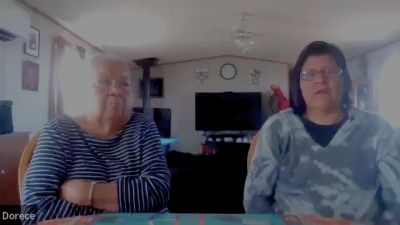 Elder Josephine Dick and her niece, Dorece Sam, |
So especially when it comes to burials, and we have a massacre site here, the special nature of burials is widely recognized in law and practice as having special qualities; they also possess a value to living groups that extend beyond the interest of archaeological research, archaeological assessment.
Why isn't there more time and effort being devoted to the value of this place in terms of it being a massacre site, and having people's ancestors literally, either buried there, or unfortunately scattered throughout that valley?
Robert Lundahl:
You know Will Falk, in the video we discussed, made the analogy to Gettysburg. And I've heard the phrase National Patrimony, so aside from this dichotomy of tribal versus non-tribal, awareness, and values assigned, from the standpoint of the country and what we learn and who we are and where our historical reckonings arise from, I thought that analogy was really good.
Also his mapping, his discussion of the mapping of the the site overall the battle, it was systemic. Where did Robert E Lee sit on his horse and watch the action? Where did the troops approach from, where did they fall- and then translating that into the Thacker Pass site, okay, you've got people running with a couple of bullets in them, where do they fall, those kinds of analyses... Can you talk about that a little bit?
A Historic District
Austin Ringelstein:
Yeah, actually Will did a really good job of spelling that out. What he's getting at there, in terms of cultural resource law, is that this is actually a designated historic district, and that means that in addition to the somewhat, not disparate, but separate archaeological sites that were recorded there's one cohesive unit that's been recorded as a historic district. That unit is, in itself, eligible to the National Register of Historic Places.
As a historic district, there's a holistic understanding of its significance.
Part of the problem with an undertaking within a historic district is that you can potentially adversely affect one part of the district which then destroys the Integrity of most or the entire place.
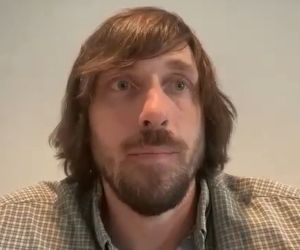 Will Falk, Attorney, Reno Sparks Indian Colony |
It's been acknowledged in the environmental impact statement that the historic district would be adversely affected by these actions.
In layperson's terms, this is a major site or major location or locale for stone tool sourcing and stone tool processing.
Most of the over 1000 archaeological sites or cultural resources sites are what are called lithic scatters with obsidian tool stone production sites within the Thacker Pass component.
What that means is that most of the archaeological sites appear to be areas where people were doing stone tool processing, making arrowheads, making scrapers and other items that indigenous people were using for processing food, but they could also be ceremonial in nature. They could have multiple meanings.
It's important to point out also that there were grinding implements and other indicators of a broader range of activities that were taking place.
They were a little bit vague in describing that here, but I looked into it a little further and the grinding implements and the other indicators of a broader range of activities actually means that there is some habitation sites that they found.
I'm going to read what it says in terms of the proposed actions under alternative “A” effects in the mining area, and exploration plan area, would adversely affect all 56 historic properties eligible under Criterion “D”, due to the loss of integrity and data from ground disturbances altering artifact and feature assemblages, temporarily sensitive remains and the depositional environment of the local landform, and in the case of obsidian quarrying locales, connection to large-scale prehistoric land use patterns within the Thacker Pass component of the DHWOPD, which is the historic district.
Historic properties also eligible under Criterion “A”, specifically the CCC remnants would suffer the same integrity and data loss.
Robert Lundahl:
That's an interesting way of saying they're going to dig a 400 foot deep pit– I mean it's sort of like, we don't want to run the truck over that, kind of writing and really, you know they're just taking up a whole valley, about at least half of it, looks like.
Austin Ringelstein:
Yeah, I mean what I'm getting at here is that I'm not at all critical of these statements, because they're just true.
There's actually admission here that the project, that huge pit that you just referenced, is going to adversely affect 56 historic properties that are National Register eligible.
So the question here is, What are they going to do about it?
And the answer that they give is incredibly vague. The mitigation for effects from the proposed action is the implementation of an approved historic properties treatment plan, in other words an HPTP, which is currently in development.
So my question is, What exactly is going to be implemented to mitigate the effects on these 56 significant sites?
That's a question I can't answer without actually speaking with the archaeologists and BLM.
Mitigo, mitigari, mitigavi, mitigatus
Robert Lundahl:
Well, what if there's no mitigation possible?
Austin Ringelstein:
Well, that's a great question. It's a really good question, Robert, because mitigation's already a tricky word to begin with. You know, I took Latin and it comes from the Latin mitigo mitigari mitigavi mitigatus, which means, in essence, to lessen or decrease so what you're getting at here is to lessen or decrease an impact, but the bottom line is there's still an impact- no matter what you offset or decrease.
I think, how many acres is it? Thousands of acres? You're having one of the largest impacts to an area that I can conceive of, and so mitigating something like that, it's almost inconceivable to understand how you mitigate it in archaeological terms.
What it might mean is monitoring and watching things either get destroyed or removed, and that's usually called a salvage effort.
But salvaging and mitigating are a little bit different because, how meaningful is your mitigation if you're just removing sensitive items and putting them in a different place holistically when it comes to an Archaeological District?
If you lose the setting and feel of that place that's a loss of integrity. There are seven aspects of Integrity that are analyzed in Section 106.
And within those seven aspects you have setting, feeling, those are just two of the seven, but those are the two that come straight to my mind that would actually be compromised by having an open pit mine there because you lose the original feeling in the original look, the original cultural value of a place that has incredible biota and incredible cultural resources.
Robert Lundahl:
Right, well it reminds me of when they built the Ivanpah solar power tower, and some of the statements that came from that time period– and I don't recall exactly whether they're attributed to Sierra Club or BLM, but in question was tortoise habitat and tortoise are protected, and this is an area that's primary tortoise habitat.
It's also an indigenous habitation site, and the statements that I heard were things like we're going to make more tortoise habitat that was a quote you know and it prompts jokes like I thought only God could make more tortoise habitat, things like that, but that's nonetheless what they said.
It meant moving tortoise, and when they moved tortoise at Fort Irwin Army Base down there in the desert they had a 50% kill rate.
So this idea of mitigation seems to be in the eye of the beholder. I mean, who benefits, and who wants what, and what you can say and get away with, am I right there or am I just cynical?
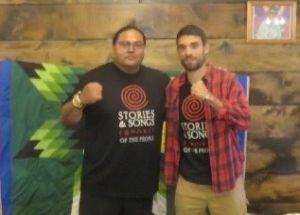 Austin Ringelstein with indigenous |
Austin Ringelstein:
Well, I think that, you know, working in the field I've worked in, mitigation is appropriate at certain times.
In the National Park Service, the bottom line is, we have trails and there are people that want to go out and enjoy trails and they happen to sometimes intersect with archaeological sites.
It doesn't mean that you throw out the baby with the bathwater and get rid of all the trails, otherwise people actually wouldn't even have access to learn about cultural heritage or learn about the beauty of nature and resonate with all that's out there. So yeah, sometimes mitigation is totally appropriate.
You know, we're going to make this trail smaller, or make sure that when we do some vegetation trimming in this area that we do it with a monitor and that we do it in a really careful and thoughtful way, and that can be good mitigation.
But when it comes to a large-scale project like this and you're talking about mitigation offsets such as removing tortoises, desert tortoises to another area, or preserving one area so that you could destroy another, personally– and I know there's various opinions out there– I see that as problematic because it's another way of kicking the can down the road.
If you already have an area that's been assigned significance and value and we're talking over a thousand archaeological sites over 50 of which have been determined to be significant under Section 106, The National Historic Preservation Act, or as most people understand it, eligible to the National Register of Historic places, and we have a major area where we know a massacre occurred in 1865– which is significant, in my opinion, and those of many others, to the history of the United States, especially in terms of the history of the Indian Wars, the so-called Indian Wars, and in terms of the development of the West, and I'm not saying that that was necessarily a good thing, but something that we can learn from.
If we destroy these areas and then say we're mitigating it because we're going to create something else somewhere, somewhere else, then what are we really doing here? Are we really protecting our heritage, or are we just destroying one place and saving another until there's nothing left?
Yes...We Want Lithium that Bad
How do we reconcile kicking the can down the road when we're starting to run out of land to protect? I've seen this too often where we call it mitigation but really we can't avoid the elephant in the room.That there's actually destruction, there's actually cultural loss, and I think one thing that gets left out of these situations that we need to remember is that there's significant human emotion involved with these types of things.
So you know, on paper, mitigation might look good at an agency level, but what do you say to the elders who are crying over the loss of their ancestors, and have to mourn maybe a second death because we want lithium that bad?
There's no denying that climate change is real and that we have an issue that we need to take care of in terms of the future generations and making sure that we can actually live on this planet.
But if we're doing that at the expense of current communities, hurting the communities that are in these lands where mineral extraction is taking place, then is that really doing our due diligence to help out future generations or are we just creating destruction in another sense?
Robert Lundahl:
At Thacker Pass we’re talking to direct descendants of the last survivor of the second massacre, so their connection via family and via family stories and via how things worked and how people lived is really strong.
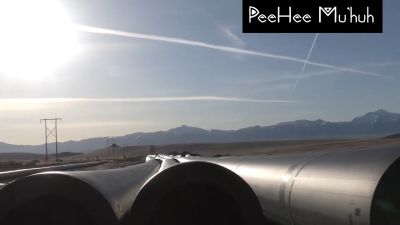 Water pipes, Thacker Pass, Peehee Muhu |
It's not necessarily dead, when they're talking about the presence of food sources on the land, and the presence of medicinal herbs on the land, and then the connections there with ceremony and religious ceremony, and prayer and practice, what I was hearing is they'd like to continue the use of that land and the way that it's always been used by them and they can't.
There was that comment about we used to pray at this certain area by, they call it Sentinel Rock, and in Paiute language they actually call it Nipple Rock, because it looks like a nipple. There's an area there where they pray that's now gated and they can't get in.
That’s a BLM decision. That's a federal decision. You're locked out. Was that appropriate and is that a good example of cultural loss in the present day to present-day peoples?
Austin Ringelstein:
Yeah and I hope it's not a loss, a permanent loss, and I imagine that if this fight continues that there can be a victory in the sense of reclaiming these areas.
Behind the Paradigm Shifts
What I'm observing is that federal law, especially cultural resource law, is behind the paradigm shifts that have happened in archeology and academia when it comes to honoring indigenous people and collaborating with indigenous communities.The paradigm shift that's happened in archeology is recognizing that we're not just doing archeology to only examine the past or interrogate the past, but we're doing it to call attention to what's in the present, and connecting the past present and future.
There's numerous, you know– I'm not the first to to say this– there's numerous indigenous scholars who are really leading that effort such as Dr. Tsim Schneider at U.C. Santa Cruz, and Dr. Sonya Atalay, in Massachusetts, who's Ojibwe.
Archeology can be a wonderful tool for actually vivifying, helping to revive and renew these relationships with the Earth and reconnecting with these places.
So at Thacker Pass, I think that what we see here is an archaeological process happening that's beholden to an outdated system and an outdated process that's constrained by time and constrained by the motives of capitalism to put profits and extraction over the needs of the people, and over the wishes of the people, and over the desires to reconnect with their ancestors and their spirituality.
And maybe it's not even just reconnecting, there's a continuity there.
There's a really great subfield in archeology called the archeologies of persistence and it's showing that a lot of these places and objects and sacred items... whereas, in the past they were they were determined to be remnants of acculturation, like if you have a glass bead mixed in with shell beads and it's a sign that there was some kind of cultural loss, and that it was less indigenous or less Native American than it was before.
But, on the contrary- what a glass bead can show is actually continuity and persistence because it shows that people were adopting non-local materials into their existing traditions.
I imagine that at Thacker Pass you have an incredible amount of continuity of practices, people continuing to gather there, people continuing to pray there over the centuries, and that story needs to be told and accounted for as part of its cultural significance.
I think it would be beneficial to the BLM and other agencies for these stories to be told. Why not make Thacker Pass not just a Cultural District but maybe a cultural historic site like Sand Creek?
Now that's not something I would determine, that would be determined through consensus. The tribes would be the ones to determine that but why not think about the infinite possibilities of the historically and culturally significant Place rather than thinking of it as an object of abstraction.
Beholden
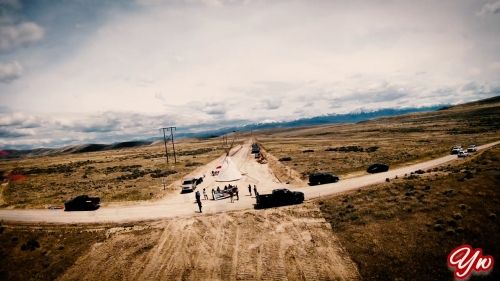 Ox Sam Camp |
Robert Lundahl:
Something in the way, something in the way of a grander ambition.
I was going to point out what we could call hypocrisy, societally, but I'd rather use the word disconnect because I think the reason that it's so important to mine lithium in the eyes of not only industry but policy makers is so that we can live in better balance with our numbers and with our machines and with our carbon dioxide releases, and so we can live in better balance, very simply, with the Earth.
And yet here you have this historic district and this historic people still there, who would like to live in balance with the Earth, and they're all too happy to share their history and their values and their beliefs and their understanding of why this could be done differently or better, not at all.
As a citizen of the United States of America, I feel like I've got an angel on one shoulder and a devil on the other. We want to do better, but we’re doing the worst possible thing. And sometimes we confuse the two.
Austin Ringelstein:
I think what you're getting at is that there's sort of this aspiration by our society to want to reach our goals in terms of climate change, and live in balance, and so-called harmony with the Earth, and here we are trying to attain that using this ends justifies means approach.
We're going to extract lithium so that we can reach this goal by 2050 of being carbon neutral, and yet we're not listening to the very people who who are indigenous to this land, who are in accord with the land, and who are in accord with these values–that promote balance and harmonious living–not in some stereotypical sense, but in a real sense.
These are indigenous people who have a better understanding of the land and its resources and its value spiritually, and holistically.
WATCH THE PODCAST/VIDEO:
SEE MORE About Myron Dewey (deceased): Person Charged in September Fatal Accident of Paiute Filmmaker Myron Dewey
#Human Rights #thesnakewars #lithium_mining #copper_mining #cobalt_mining #humanity #minerals #Fort_McDermitt_Paiute #Shoshone_Tribe #Winnemucca_Indian_Colony #Summit_Lake_Paiute_Tribe #firstAmericans #indigenouspeoples
Articles for June 2, 2023 | Articles for June 3, 2023 |


Quick Links
DINING
Willamette UniversityGoudy Commons Cafe
Dine on the Queen
Willamette Queen Sternwheeler
MUST SEE SALEM
Oregon Capitol ToursCapitol History Gateway
Willamette River Ride
Willamette Queen Sternwheeler
Historic Home Tours:
Deepwood Museum
The Bush House
Gaiety Hollow Garden
AUCTIONS - APPRAISALS
Auction Masters & AppraisalsCONSTRUCTION SERVICES
Roofing and ContractingSheridan, Ore.
ONLINE SHOPPING
Special Occasion DressesAdvertise with Salem-News
Contact:AdSales@Salem-News.com
Salem-News.com:


Terms of Service | Privacy Policy
All comments and messages are approved by people and self promotional links or unacceptable comments are denied.
[Return to Top]
©2025 Salem-News.com. All opinions expressed in this article are those of the author and do not necessarily reflect those of Salem-News.com.